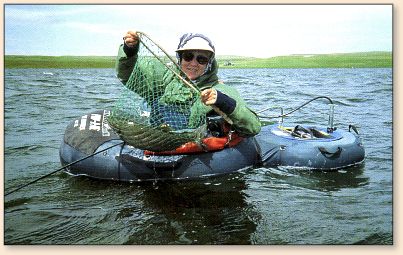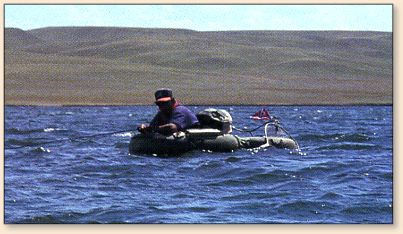Weather Changes and Strategies
Usually fly fishers consider wind to be an enemy,
but for lake fishing it can mean the difference
between catching and not catching fish, particularly
during the summer doldrums when the trout are less
active and hatches have slowed down. Wind stirs up
the surface water which both oxygenates it and
reduces the temperature, thus making the surface
water more comfortable for insects and trout. Fish
and fish food will often rise from the depths to
this zone of comfort. Also, on cloudy, stormy days
trout may feel less vulnerable and may be more
willing to approach the surface.
The best fishing on a windy day is on the downwind
shore (the direction that the wind blows toward)
because insects will be blown in that direction
and pile up along the shoreline. Wind currents
may also stir up the weeds causing the release
of insects from their safe hiding places. Surface
rising fish will face the waves to catch food that
is moved by the wind, so you need to angle your
cast up into the wind and let your fly drift to
the fish. When the fish are feeding at deeper
levels on windy days cast downwind. The lower
water currents run opposite the surface wave
action as they bounce off the shore and cause
the fish to again face into the current. You can
station yourself off shore, kick backward and cast
toward the shore.

While there are some advantages to a windy day,
wind can also be problematic. [That's the author
in the photo above reaping the rewards the
wind bring to the trout and the fly fisher.]
Casting into the wind is hard work and can make
it difficult to cast accurately. In addition, it
can be difficult to control your line and to position
yourself in a strategic place. Long rods matched for heavy
weight lines (8-9) help counteract the force of
the wind, along with changing casting techniques.
The backcast should be snapped just past the 12
o'clock position, pause for line straightening
and loading and then a forceful forward movement,
stopping at the 9 o'clock position for release.
And, the cast should be angled toward the wind
rather than directly into it. If you cast directly
upwind, you will find line around your feet and in
casting directly downwind you may drift right into
your line.
A word of caution regarding tubing in windy weather.
Waves may lap all around you and into your tube,
but your tube will not sink. With rain gear you
won't even get wet. The danger comes from
overestimating your own stamina to kick back to
shore and/or underestimating the strength of the
wind. If you have concerns about your ability to
kick back to your launching place, it is best to
move close to shore where you can still take
advantage of windy fishing opportunities. And,
if you are caught in a heavy wind that you cannot
handle, don't panic. You may need to let yourself
be blown to shore and either walk back or wait for
the wind to subside before returning to your launch
site.

Although inclement weather, particularly wind,
can improve fishing, large storm systems with
fluctuating barometric pressure can also turn
the fishing off. Barometric pressure changes
are associated with both fishing success and/or
failure. With rapid barometric changes, either
high or low, there is often an associated increase
in insect activity and trout feeding, thus making
for good fishing. However, if the barometer begins
to drop slowly, you may notice in the middle of
a productive hatch a sudden drop in insect
activity and in fish feeding. Also, if the
hatch you were expecting at 10 a.m. fails to
arrive, it could also be related to weather
changes. When the weather interferes with
hatching and you want to continue fishing,
you should switch to crustaceans, leeches
and nymphs near the bottom rather than on
rising insects such as emerging damsel or
Callibaetis nymphs. ~ PCP
More Strategies next time.
Credits: Excerpt from Float Tube
Magic By Patricia C. Potheir, published
by Frank Amato Publications. We appreciate use
permission.
|



